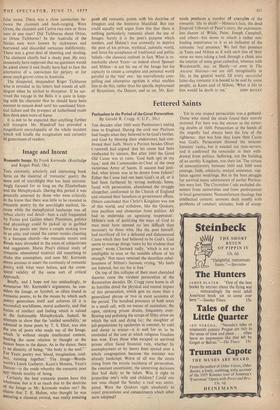Image and Intent
runs extremely scholarly and interesting book turns on the material of 'romantic' poetry the same sort of searchlight that has been unremit- ingly focused for so long on the Elizabethans and the Metaphysicals. During this period it was generally assumed by those who were critically in the know that there was little to be revealed in romantic poetry by the searchlight method, be- cause while the metaphysical landscape was all Urban clarity and detail—here a café frequented by Ficino and Galileo where Platonism, politics and physiology could be picked up in garbled form for poetic use; there a couple making love n an attic; and round the corner monks chanting in a baroque church—the romantic moors and floods were shrouded in the mists of subjectivism and suggestion. Mario Praz's clinical study of romantic obsessional material did something to shake this assumption, and now Mr. Kermode seems anxious to assert the continuity of romantic Poetry with what went before, and the conse- quent validity of the same sort of critical approach.
Briefly, and I hope not too misleadingly, to summarise Mr. Kermode's arguments, he con- siders the Image, or Symbol, so often found in romantic poems, to be the means by which such Poetry generalises itself and achieves (if it is successful) worldliness, moral authority, and that fusion of intellect and feeling which is valued in the fashionable Metaphysicals. Indeed, he attempts to show that the 'unified sensibility,' so admired in those poets by T. S. Eliot, was also the aim of poets who made use of the Image, Which 'is without simple intellectual content, bearing the same relation to thought as the lancer bears to the dance. As in the dance, there is no disunity of being; "the body is the soul."' For Yeats, poetry was 'blood, imagination, intel- lect, running together.' The Image—Words- worth's Leech Gatherer, Keats's Moneta, Yeats's bancer—is the mode whereby the romantic poet aPIrehends totality of being. Certainly the best romantic poems have this Wholeness, but is it as much due to the doctrine of the Image as Mr. Kermode makes out? He .claims that T. E. Hulme, who thought he was initiating a classical revival, was really restating good old romantic points with his doctrine of Imagism and the Intensive Manifold. But one could equally well argue from this that there is nothing particularly romantic about the use of Images. Surely it is the poet's purpose which matters, and Hulme's was avowedly to deprive the poet of his private, mythical, autotelic world, and force his acceptance of traditional and public beliefs—the classical outlook in fact. What is re- markable about Yeats—as indeed about Spenser and Milton—is not his use of the Image but his capacity to create a complete and personal world parallel to the 'real' one: his marvellously com- pelling and absorptive egotism is what enables him to do this, rather than his specific deployment of Byzantium, the Dancer, and so on. Mr. Ker-
mode produces a number of examples of the romantic 'life in death'—Moneta's face, the dead Emerald Uthwart of Pater's story, the expression- less dancer of Wilde, Pater, Joseph Campbell, and others—but seems to attach a rather mis- leading importance to it as an indicator of the romantic 'real presence.' We feel that presence in Yeats and Milton as if with each line of their verse we were taking a look through a chink into the interior of some great cathedral, whereas with Wordsworth, say, or Hardy—or even in The Ancient Mariner—we are still recognisably in life, in the general world. Of every successful latter-day romantic it is bound to be said by some people, as Keats said of Milton, 'What is life to
him would be death to me.' JOHN BAYLEY


































 Previous page
Previous page